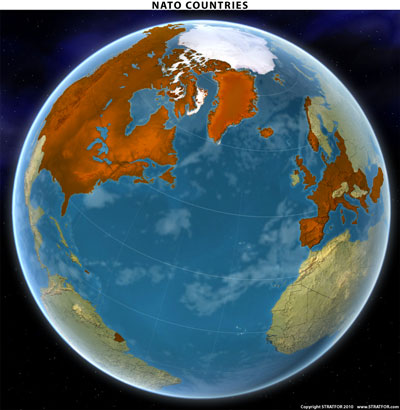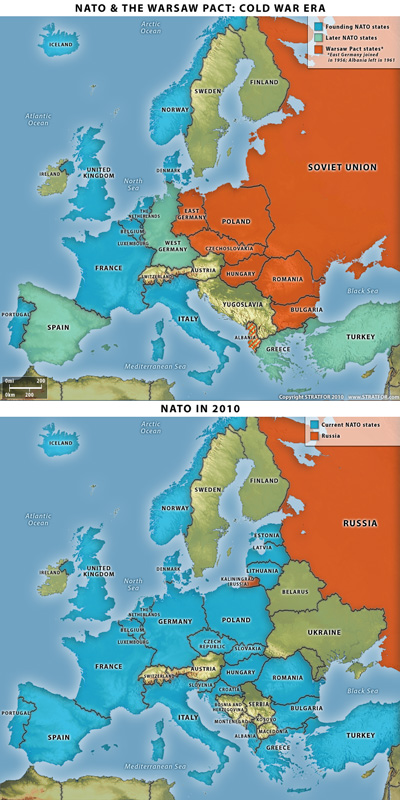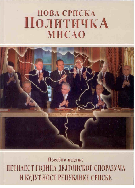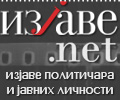| NSPM in English | |||
NATO's Lack of a Strategic Concept |
 |
 |
 |
| среда, 13. октобар 2010. | |
|
(STRATFOR, October 12, 2010)
During the Cold War, the presence of 50 Soviet and Warsaw Pact armored divisions and nearly 2 million troops west of the Urals spoke far louder than mission statements. While Strategic Concepts were put out in 1949, 1952, 1957 and 1968, they merely served to reinforce NATO’s mission, namely, to keep the Soviets at bay. Today, the debate surrounding NATO’s Strategic Concept itself highlights the alliance’s existential crisis. The Evolution of NATO’s Threat Environment The Cold War was a dangerous but simple era. The gravity of the Soviet threat and the devastation of continental Europe after World War II left the European NATO allies beholden to the United States for defense. Any hope of deterring an ambitious USSR resided in Washington and its nuclear arsenal. This was not a matter of affinity or selection on the basis of cultural values and shared histories. For Western Europeans, there was little choice as they faced a potential Soviet invasion. That lack of choice engendered a strong bond between the alliance’s European and North American allies and a coherent mission statement. NATO provided added benefits of security with little financial commitment, allowing Europeans to concentrate on improving domestic living standards, giving Europe time and resources to craft the European Union and expansive welfare states. For the Americans, this was a small price to pay to contain the Soviets. A Soviet-dominated Europe would have combined Europe’s technology and industrial capacity with Soviet natural resources, manpower and ideology, creating a continent-sized competitor able to threaten North America. The threat of a Soviet invasion of Europe was the only mission statement NATO needed. The alliance had few conventional counters to this threat. While the anti-tank technology that began to come online toward the end of the Cold War began to shift the military balance between NATO and the Warsaw Pact, much of it remained unproven until Operation Desert Storm in 1991, well after the Soviet threat had passed. This technological and qualitative innovation came at an immense expense and was the direct result of the alliance’s quantitative disadvantage. The Warsaw Pact held a 2-to-1 advantage in terms of main battle tanks in 1988. There was a reason the Warsaw Pact called its battle plan against NATO the Seven Days to the Rhine, a fairly realistic description of the outcome of the planned attack (assuming the Soviets could fuel the armored onslaught, which was becoming a more serious question by the 1980s). In fact, the Soviets were confident enough throughout the Cold War to maintain a no-first-use policy on nuclear weapons in the belief that their conventional advantage in armor would yield quick results. NATO simply did not have that luxury. It should be noted that Western Europe and the United States disagreed on interests and strategies during the Cold War as well. At many junctures, the Western Europeans sought to distance themselves from the United States, including after the Vietnam War, which the United States fought largely to illustrate its commitment to them. In this context, the 1969 policy of Ostpolitik by then-West German Chancellor Willy Brandt toward the Soviets might not appear very different from the contemporary Berlin-Moscow relationship — but during the Cold War, the Soviet tank divisions arrayed on the border of West and East Germany was a constant reality check that ultimately determined NATO member priorities. Contradictory interests and momentary disagreements within the alliance thus remained ancillary to the armored formations conducting exercises simulating a massive push toward the Rhine. The Cold War threat environment was therefore clear and severe, creating conditions that made NATO not only necessary and viable but also strong in the face of potential disagreements among its members. This environment, however, did not last. Ultimately, NATO held back the Soviet threat, but in its success, the alliance sowed the seeds for its present lack of focus. The Warsaw Pact threat disappeared when the pact folded in mid-1991 and the Soviet Union collapsed at the end of 1991. Moscow unilaterally withdrew its sphere of influence from the Elbe River at the old West-East German border to behind the Dnieper River some 1,000 kilometers farther east. Throughout the 1990s, the danger from Russia lay in nuclear proliferation resulting from its collapse, prompting the United States and its NATO allies to begin to prop up the chaotic government of Boris Yeltsin. Meanwhile, the momentary preponderance of American power allowed the West to dabble in expeditionary adventures of questionable strategic value — albeit in the former border regions between NATO and the West — and the alliance searched for a mission statement in humanitarian interventions in the Balkans. Disparate Threats and Interests With each passing year of the post-Cold War era, the threat environment changed. With no clear threat in the east, NATO enlargement into Central Europe became a goal in and of itself. And with each new NATO member state came a new national interest in defining that threat environment, and the unifying nature of a consensus threat environment further weakened. Three major developments changed how different alliance members formulate their threat perception. First, 9/11 brought home the reality of the threat represented by militant Islamists. The attack was the first instance in its history that NATO invoked Article 5, which provides for collective self-defense. This paved the way for NATO involvement in Afghanistan, well outside NATO’s traditional theater of operations in Europe. Subsequent jihadist attacks in Spain and the United Kingdom reaffirmed the global nature of the threat, but global terrorism is not 50 armored divisions. The lukewarm interest of many NATO allies regarding the Afghan mission in particular and profound differences over the appropriate means to address the threat of transnational terrorism in general attest to the insufficiency of militant Islam as a unifying threat for the alliance. For most European nations, the threat of jihadism is not one to be countered in the Middle East and South Asia with expeditionary warfare, but rather at home using domestic law enforcement amid their own restive Muslim populations — or at the very most, handled abroad with clandestine operations conducted by intelligence services. Europeans would therefore like to shift the focus of the struggle to policing and intelligence gathering, not to mention cost cutting in the current environment of fiscal austerity across the Continent. Washington, however, still has both a motivation to bring the senior leadership of al Qaeda to justice and a strategic interest in leaving Afghanistan with a government capable of preventing the country from devolving into a terrorist safe haven. As STRATFOR has argued, both interests are real but are overcommitting the United States to combating the tactic of terrorism and the threat of transnational jihad at the cost of emerging (and re-emerging) threats elsewhere. To use poker parlance, Washington has committed itself to the pot with a major bet and is hesitant to withdraw despite its poor hand. With so many of its chips — e.g., resources and political capital — already invested, the United States is hesitant to fold. Europeans, however, have essentially already folded. Second, NATO’s enlargement to the Baltic states combined with the pro-Western Georgian and Ukrainian color revolutions — all occurring in a one-year period between the end of 2003 and end of 2004 — jarred Moscow into a resurgence that has altered the threat environment for Central Europe. Russia saw the NATO expansion to the Baltic states as revealing the alliance’s designs on Ukraine and Georgia, and it found this unacceptable. Considering Ukraine’s geographic importance to Russia — it is the underbelly of Russia, affording Moscow’s enemies an excellent position from which to cut off Moscow’s access to the Caucasus — it represents a red line for any Russian entity. The Kremlin has countered the threat of losing Ukraine from its sphere of influence by resurging into the old Soviet sphere, locking down Central Asia, Belarus, the Caucasus and Ukraine via open warfare (in the case of Georgia), political machinations (in the case of Ukraine and soon Moldova) and color revolutions modeled on the West’s efforts (in the case of Kyrgyzstan). For Western Europe and especially Germany, sensitive to its dependencies on, and looking to profit from its energy and economic exchange with, Russia, Moscow’s resurgence is a secondary issue. Core European powers do not want a second Cold War confrontation with Russia. While it is of more importance for the United States, current operations have left U.S. ground combat forces overcommitted and without a strategic reserve. It is a threat Washington is reawakening to, but that remains a lower priority than ongoing efforts in both Afghanistan and Iraq. When the United States does fully reawaken to the Russian resurgence, it will find that only a portion of NATO shares a similar view of Russia. That portion is in the Central European countries that form NATO’s new borderlands with Russia, for whom a resurgent Moscow is the supreme national threat. By contrast, France and Germany — Europe’s heavyweights — do not want another Cold War splitting the Continent. Third, Europe’s severe economic crisis has made Germany’s emergence as the political leader of Europe plain to all. This development was the logical result of the Cold War’s end and of German reunification, though it took 20 years for Berlin to digest East Germany and be presented with the opportunity to exert its power. That opportunity presented itself in the first half of 2010. Europe’s fate in May 2010 amid the Greek sovereign debt crisis hinged not on what the EU bureaucracy would do, or even on what the leaders of most powerful EU countries would collectively agree on, but rather what direction came from Berlin. This has now sunk in for the rest of Europe. Berlin wants to use the current crisis to reshape the European Union in its own image. Meanwhile, Paris wants to manage Berlin’s rise and preserve a key role for France in the leadership of the European Union. Western Europe therefore wants to have the luxury it had during the Cold War of being able to put its house in order and wants no part of global expeditionary warfare against militant Islamists or of countering Russian resurgence. Central Europeans are nervously watching as Paris and Berlin draw closer to Moscow while committed Atlanticists — Western European countries traditionally suspicious of a powerful Germany — such as Denmark, the Netherlands and the United Kingdom want to reaffirm their trans-Atlantic security links with the United States in light of a new, more assertive, Germany. The core of Western European NATO members is thus at war with itself over policy and does not perceive a resurgent Russia as a threat to be managed with military force. The Beginning of the End Amid this changed threat environment and expanded membership, NATO looks to draft a new mission statement. To do so, a “Group of Experts” led by former U.S. Secretary of State Madeleine Albright has drafted a number of recommendations for how the alliance will tackle the next 10 years. This Thursday, NATO member states’ defense ministers will take a final look at the experts’ recommendations before they are formulated into a draft Strategic Concept that the secretary-general will present to heads of state at the aforementioned November Lisbon summit. Though some recommendations do target issues that plague the alliance, they fail to address the unaddressable, namely, the lack of a unified perception of threats and how those threats should be prioritized and responded to. Ultimately, the credibility and deterrent value of an alliance is rooted in potential adversaries’ perception of the alliance’s resolve. During the Cold War, that resolve, while never unquestioned — the Europeans were always skeptical of U.S. willingness to risk New York and Washington in a standoff with Russia over European turf — was strong and repeatedly demonstrated. The United States launched proxy wars in Korea and Vietnam largely to demonstrate unequivocally to European governments — and the Kremlin — that the United States was willing to bleed in far corners of the planet for its allies. U.S. troops stationed in West Germany, some of whom were in immediate danger of being cut off in West Berlin, served to demonstrate U.S. resolve against Soviet armor poised on the North European Plain and just to the east of the Fulda Gap in Hesse. Recent years have not seen a reaffirmation of such resolve, but rather the opposite when the United States — and NATO — failed to respond to the Russian military intervention in Georgia, a committed NATO aspirant though not a member. This was due not only to a lack of U.S. forces but also to Germany’s and France’s refusal to risk their relationships with Russia over Georgia. Thus, at the heart of NATO today lies a lack of resolve bred in the divergent interests and threat perceptions of its constituent states. The disparate threat environment is grafted on to a membership pool that can be broadly split into three categories: the United States, Canada and committed European Atlanticists (the United Kingdom, the Netherlands and Denmark); Core European powers (led by Germany and France, with southern Mediterranean countries dependant on Berlin’s economic support in tow); and new Central European member states, the so-called Intermarum countries that stretch from the Baltic to the Black seas that are traditionally wary of Russian power and of relying on an alliance with Western Europe to counter such power. With no one clear threat to the alliance and with so many divergent interests among its membership, the Group of Experts recommendations were largely incompatible. A look at the recommendations is enough to infer which group of countries wants what interests preserved and therefore reveal the built-in incompatibility of alliance interests going forward from 2010. · Atlanticists: Led by the United States, Atlanticists want the alliance oriented toward non-European theaters of operation (e.g., Afghanistan) and non-traditional security threats (think cybersecurity, terrorism, etc.); an increase of commitments from Core Europeans in terms of defense spending; and a reformed decision-making system that eliminates a single-member veto in some situations while allowing the NATO secretary-general to have predetermined powers to act without authorization in others. The latter is in the interests of the United States, because it is Washington that will always have the most sway over the secretary-general, who traditionally hails from an Atlanticist country. · Core Europe: Led by Germany and France, Core Europe wants more controls and parameters predetermined for non-European deployments (so that it can limit such deployments); a leaner and more efficient alliance (in other words, the freedom to cut defense spending when few are actually spending at the two percent gross domestic product mandated by the alliance); and more cooperation and balance with Russia and more consultations with international organizations like the United Nations (to limit the ability of the United States to go it alone without multilateral approval). Core Europe also wants military exercises to be “nonthreatening,” in direct opposition to Intermarum demands that the alliance reaffirm its defense commitments through clear demonstrations of resolve. · Intermarum: The Central Europeans ultimately want NATO to reaffirm Article 5 both rhetorically and via military exercises (if not the stationing of troops); commitment to the European theater and conventional threats specifically (in opposition to the Atlanticists’ non-European focus); and mention of Russia in the new Strategic Concept as a power whose motives cannot be trusted (in opposition of Core European pro-Russian attitudes). Some Central Europeans also want a continued open-door membership policy (think Ukraine and Georgia) so that the NATO border with Russia is expanded farther east, which neither the United States nor Core Europe (nor even some fellow Intermarum states) have the appetite for at present. The problem with NATO today, and for NATO in the next decade, is that different member states view different threats through different prisms of national interest. Russian tanks concern only roughly a third of member states — the Intermarum states — while the rest of the alliance is split between Atlanticists looking to strengthen the alliance for new threats and non-European theaters of operations and the so-called “Old Europe” that looks to commit as few soldiers and resources as possible toward either set of goals in the next 10 years. It is unclear how the new Strategic Concept will encapsulate anything but the strategic divergence in NATO- member interests. NATO is not going away, but it lacks the unified and overwhelming threat that has historically made enduring alliances among nation-states possible — much less lasting. Without that looming threat, other matters — other differences — begin to fracture the alliance. NATO continues to exist today not because of its unity of purpose but because of the lack of a jarringly divisive issue that could drive it apart. Thus, the oft-repeated question of “relevance” — namely, how does NATO reshape itself to be relevant in the 21st century — must be turned on its head by asking what it is that unifies NATO in the 21st century. During the Cold War, NATO was a military alliance with a clear adversary and purpose. Today, it is becoming a group of friendly countries with interoperability standards that will facilitate the creation of “coalitions of the willing” on an ad-hoc basis and of a discussion forum. This will give its member states a convenient structure from which to launch multilateral policing actions, such as combating piracy in Somalia or providing law enforcement in places like Kosovo. Given the inherently divergent core interests of its member states, the question is what underlying threat will unify NATO in the decade ahead to galvanize the alliance into making the sort of investments and reforms that the Strategic Concept stipulates. The answer to that question is far from clear. In fact, it is clouded by its member states’ incompatible perceptions of global threats, which makes us wonder whether the November Summit in Lisbon is in fact the beginning of the end for NATO. By Marko Papic Recommended External Link: NATO 2020: Assured Security; Dynamic Engagement "NATO's Lack of a Strategic Concept | STRATFOR is republished with permission of STRATFOR." |
Од истог аутора
- The Nabucco West Project Comes to an End
- Remaking the Eurozone in a German Image
- Serbia: A Weimar Republic?
- Surveying Turkish Influence in the Western Balkans
- The Geopolitics of Turkey: Searching for More
- Kosovo – Consequences of the ICJ Opinion
- Kyrgyzstan and the Russian Resurgence
- Russia, Belarus, Kazakhstan: A Customs Deal and a Way Forward for Moscow
- Montenegro's Membership in NATO and Serbia's Position
- ЕУ: Убрзано ширење на Балкан
- The Return of Germany
Остали чланци у рубрици
- Playing With Fire in Ukraine
- Kosovo as a res extra commercium and the alchemy of colonization
- The Balkans XX years after NATO aggression: the case of the Republic of Srpska – past, present and future
- Из архиве - Remarks Before the Foreign Affairs Committee of the European Parliament
- Dysfunction in the Balkans - Can the Post-Yugoslav Settlement Survive?
- Serbia’s latest would-be savior is a modernizer, a strongman - or both
- Why the Ukraine Crisis Is the West’s Fault
- The Ghosts of World War I Circle over Ukraine
- Nato's action plan in Ukraine is right out of Dr Strangelove
- Why Yanukovych Said No to Europe

.jpg)
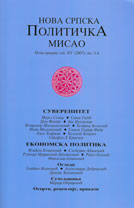
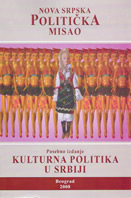
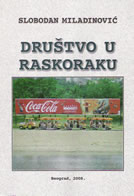
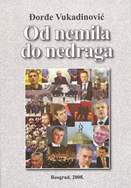
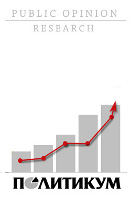



 Twenty-eight heads of state of the North Atlantic Treaty Organization (NATO) will meet in Lisbon on Nov. 20 to approve a new “Strategic Concept,” the alliance’s mission statement for the next decade. This will be NATO’s third Strategic Concept since the Cold War ended. The last two came in 1991 — as the Soviet Union was collapsing — and 1999 — as NATO intervened in Yugoslavia, undertaking its first serious military engagement.
Twenty-eight heads of state of the North Atlantic Treaty Organization (NATO) will meet in Lisbon on Nov. 20 to approve a new “Strategic Concept,” the alliance’s mission statement for the next decade. This will be NATO’s third Strategic Concept since the Cold War ended. The last two came in 1991 — as the Soviet Union was collapsing — and 1999 — as NATO intervened in Yugoslavia, undertaking its first serious military engagement.